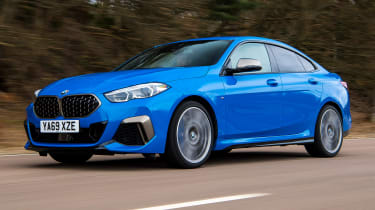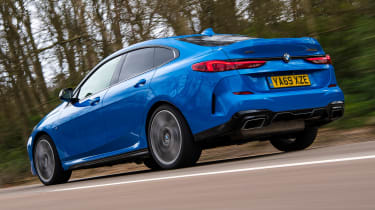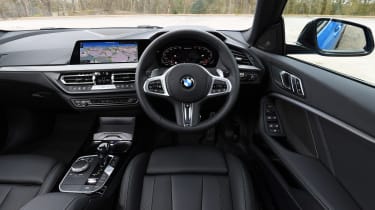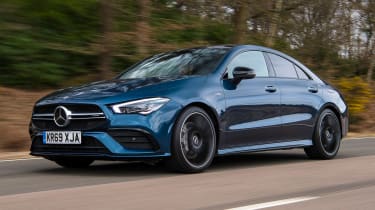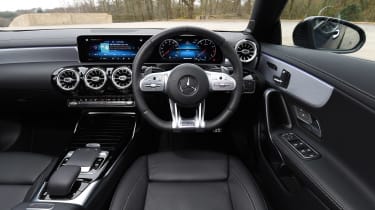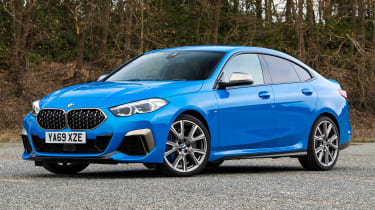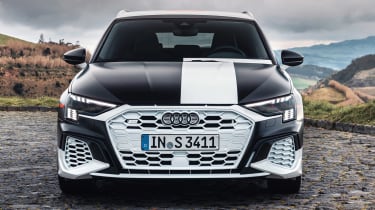The BMW M235i and Mercedes-AMG CLA 35 promise hot-hatch performance and four-door coupe style – we find out which fills the brief better
Hatchbacks are the norm in the UK, and even when it comes to performance models, British buyers usually prefer hot cars with five doors. But if you’re not after the norm and want to break from tradition, you can opt for a small four-door coupé instead – and the new BMW 2 Series Gran Coupé and Mercedes CLA are two upmarket options with performance-focused flagships.
Our first contender here is the BMW M235i xDrive Gran Coupé, which takes on the Mercedes-AMG CLA 35. The cars are evenly matched, with the same power outputs from their turbocharged four-cylinder engines and similar bodystyles. They’re both four-wheel drive and use automatic gearboxes, too.
New 2019 Mercedes-AMG CLA 45 S review
These models have to deliver similar ability to a hot hatch, so they’ll need to live up to their M Performance and AMG badges respectively, yet also offer practicality and premium tech.
BMW M235i Gran Coupe
| BMW M235i xDrive Gran Coupé | |
| Price: | £37,595 |
| Engine: | 2.0-litre 4cyl petrol, 302bhp |
| 0-60mph: | 5.0 seconds |
| Test economy: | 37.7mpg/8.3mpl |
| CO2: | 172g/km |
| Annual road tax: | £150 |
The previous-generation BMW 2 Series was rear-wheel drive, but this new model, which is launched with this new Gran Coupé bodystyle, is predominantly front-wheel drive. However, the flagship M235i tested here uses BMW’s xDrive four-wheel drive and costs from £37,595.
Design & engineering
This 2 Series Gran Coupé uses BMW’s UKL2 platform, so it shares parts with the 1 Series hatchback and some MINI models. The engine layout is transverse and there’s four-wheel drive, which is the same layout as in the CLA.
Both cars use 2.0-litre turbocharged four-cylinder engines, too. This is a big change for the BMW, because the previous M235i and M240i two-door coupés used a straight six and were available with a manual gearbox. The new model is auto-only, and its eight-speed box has one more ratio than the CLA’s.
More reviews for 2 Series
In-depth reviews
- BMW 2 Series Convertible review
- BMW 2 Series Gran Tourer review
Road tests
- New BMW M235i xDrive Gran Coupe 2020 review
- New BMW 2 Series Gran Coupe 2020 review
- New BMW M2 CS prototype review
Used car tests
- Used BMW 2 Series Active Tourer review
- Used BMW 2 series review
Both cars have 302bhp, although the BMW’s motor produces this at 5,000rpm, which is 800rpm lower than the AMG’s engine. It also has 450Nm of torque, which is 50Nm more than the Mercedes’.
There’s a clever new traction control system, which is more closely integrated with the powertrain to improve its responsiveness. As well as different driving modes, both cars have a sportier ESC setting that allows you to explore their limits without turning it fully off.
Adaptive dampers are available on the M235i for £500, while as standard you get uprated brakes and suspension settings on this hot model, as well as 18-inch alloys and sportier trim inside and out.
Interior build quality is high, and there are plenty of plush materials and interesting finishes to make the car feel upmarket. It’s on par with the Mercedes in this respect, although some key touchpoints such as the indicator and wiper stalks feel more premium than the plasticky items found in the CLA. On the other hand, there’s more tech in the Mercedes.
This M235i has Live Cockpit Professional as standard, so there’s a dual infotainment and instrument display set-up to match its rival’s. Standard equipment includes heated Alcantara sports seats, cruise control, LED headlights, sat-nav, Apple CarPlay, keyless go and upgraded brakes.
Driving
The M235i is good to drive, but we’re not sure it does enough to justify its M Performance identity – because previous models with this badge were more exciting.
There’s a decent amount of grip, and while the steering isn’t as precise as we’d like, agility is the BMW’s strongest point. The clever ESC actually helps turn the car sharply into a bend if you lift off the throttle. Once you’ve done this, you can get on the gas again and the four-wheel-drive system gets to work pointing you in a straight line again, and there’s lots of traction to lean on.
You can feel the systems working together to tighten the car’s line through each corner, and it adds to the experience, rather than detracting from it. However, the powerful engine and large tyres mean that you have to be going pretty fast to exploit the car in this way. It’s the same story in the Mercedes, but the cars’ performance and grip come to the fore in poorer conditions.
However, neither car’s engine is the most effervescent or characterful, and they’re a little disappointing as a result. It’s partly because they feel – and sound – flat, but this comes from their incredibly linear power delivery.
The M235i took just five seconds to go from 0-60mph at the track, which was 0.1 seconds ahead of its rival. Similarly, it took four seconds to go from 30-70mph through the gears, which again was 0.1 seconds ahead of the CLA 35.
This is partly because of the eight-speed gearbox, which has an extra ratio and delivers quick shifts, but they’re not as crisp as those in the AMG. The BMW suffers slightly from jerky shifts if you accelerate quickly, but it’s smooth when driving normally.
Our M235i test car wasn’t fitted with adaptive dampers, but even on fixed-rate suspension, it rides smoothly enough to match the adaptive-equipped CLA in Comfort mode. There’s a small amount of body roll, but it’s still composed and the BMW is comfortable enough.
Practicality
Rear-seat space is about the same as in the CLA. Both cars are four-door coupés, so headroom is tighter than in their hatchback equivalents, but the seats are comfortable enough and legroom is fine, because your legs rest away from the front-seat backs.
There’s 430 litres of boot space in the M235i, which is 30 litres down on the CLA. Neither car is hugely practical for items such as bikes or buggies because they have saloon tailgates, but there’s plenty of space for shopping and overnight bags or smaller cases.
Ownership
EURO NCAP hasn’t tested the 2 Series, but the 1 Series it’s closely related to earned a full five stars when it was tested in 2019. There’s AEB as standard but lane-keep and blind-spot assist are in a £1,000 option pack.
Readers ranked BMW 27th out of 30 manufacturers in our 2020 Driver Power survey. This is poor, but it was one place ahead of Mercedes.
Running costs
These models use powerful turbocharged petrol engines, but both still showed respectable fuel economy on test. The BMW returned 37.7mpg, while the Mercedes returned 36.0mpg, which works out at £1,600 and £1,676 on fuel per year respectively, over 12,000 miles.
Fixed-price servicing costs £20 a month for
three years on the M235i, which is £10 a month cheaper than the same package on the CLA 35
Mercedes-AMG CLA 35
| Mercedes-AMG CLA 35 4MATIC | |
| Price: | £40,310 |
| Engine: | 2.0-litre 4cyl petrol, 302bhp |
| 0-60mph: | 5.1 seconds |
| Test economy: | 36.0mpg/7.9mpl |
| CO2: | 173g/km |
| Annual road tax: | £475 |
The CLA 35 isn’t the top model in the range, unlike the M235i; there’s a CLA 45 that’s
even more powerful and expensive. But at £40,310, the 35 is more affordable yet still offers plenty of grunt, and is the BMW’s natural rival.
Design & engineering
The CLA uses Mercedes’ MFA2 platform, so it shares parts with the A-Class, just as the M235i is based on the 1 Series.
The CLA 35 uses a 2.0-litre four-cylinder engine, and with 302bhp, it matches the M235i’s power output. It drives all four wheels through a seven-speed automatic gearbox, but it’s a dual-clutch transmission, not a conventional auto as found in the BMW.
There are MacPherson struts at the front and a multi-link set-up at the rear, allowing for 4MATIC four-wheel drive. Adaptive dampers are standard on models with the Premium Plus pack (£6,000), with a choice between Comfort, Sport and Sport+ modes that increases stiffness in each setting. All cars have these drive modes, which affect steering and powertrain response only in base models. Our car had this pack fitted, so it also featured 19-inch alloys, adaptive LED lights, a panoramic roof and a Burmester stereo.
Standard kit on the CLA 35 includes a DAB radio, a reversing camera, cruise control, LED lights, lane-keep assist and AEB. There’s also the MBUX infotainment set-up, which features navigation, Android Auto, Apple CarPlay and more connected features.
The rest of the interior is just as good as the BMW’s, because while there are a few cheap-looking materials, like the indicator and gear selector stalks, most are of high quality and look slicker than the BMW’s. The seats, steering wheel and other touchpoints are as upmarket as you would expect from a premium car maker.
Driving
On adaptive dampers in Comfort mode, the CLA 35 isn’t noticeably stiffer or softer than its rival here on fixed-rate dampers. But if you swap into Sport or Sport+ mode, it does firm up. There’s decent body control even in the Comfort setting, though, so it’s good that Individual mode lets you use sportier engine and gearbox settings, but keep the dampers soft.
The CLA rides well, and even on big wheels offers a little more compliance and sophistication to how it deals with bumps compared with the BMW. Only big inputs and potholes thud into the cabin, and the car is smooth enough at motorway speeds.
The steering is nice and quick, with enough precision to place the car on the road easily. Importantly, as well as having a more adjustable balance between ride comfort and body control, the feel is also much sweeter than the BMW’s. The M235i’s steering feels squidgy, mute and a bit resistive; while the CLA’s isn’t brimming with feedback, it has better weight and more consistency.
There’s lots of grip, too, so turn-in is sharp – the CLA 35 is quite a bit more fun to drive than a normal CLA or A-Class. The BMW doesn’t have this big step up with the M235i model, but that’s because the normal versions feel sporty anyway.
The CLA isn’t quite as willing as the M235i to bring its rear axle into play when cornering aggressively, but there’s enough agility to get the car moving when you want it to. As with its rival, such is the security of the level of grip and traction on offer that you have to be pushing hard to do this. At least that means both cars will be good in winter. The CLA 35’s over-riding balance feels planted, with strong performance to power out of corners cleanly.
In our tests, the Mercedes took 5.1 seconds to go from 0-60mph, which was 0.1 seconds slower than its rival, but felt indistinguishable from behind the wheel. Acceleration like this is impressive, but is expected of modern performance cars. The linear power delivery can sometimes leave them feeling a little flat, even if they are impressively consistent.
In-gear acceleration was just as strong as the 0-60mph sprint, and the CLA 35 took just two seconds to go from 30-50mph in third, and 4.1 seconds from 50-70mph in fifth. The BMW took 2.3 seconds to do the former and 3.6 seconds to do the latter. The reason it was faster from 50-70mph was because of its eight-speed gearbox; in the higher gears the M235i runs slightly shorter ratios to improve performance.
The gearbox in the CLA performs well in the same situations as the BMW’s auto box. It’s smooth when driving normally and picks ratios well in auto mode, and while the changes are sharp and quick when they happen, there’s just a little delay between pulling the paddle and the new gear engaging.
Practicality
The CLA has a 460-litre boot, which is 30 litres bigger than the M235i’s. It’s slightly harder to load items because there’s a bigger loading lip, but the extra space more than makes up for this.
There’s enough legroom in the rear for adults, yet they might feel cramped after spending more than a short time because there’s limited headroom – but the same is true in the BMW, due to these cars’ bodies. It will be fine for kids, though, and storage is pretty good, thanks to a bin in the centre console.
Ownership
Mercedes performed poorly in our 2020 Driver Power satisfaction survey, taking 28th place. Neither German brand impressed its customers, though.
Euro NCAP gave the CLA a five-star safety rating, and the kit list backs this up. AEB is standard, just as in its rival, but you also get lane assist and nine airbags.
Running costs
Our experts predict that the Mercedes and BMW will hold their value well after three years or 36,000 miles, with residual values of 45.5 per cent and 51.2 per cent respectively.
The BMW will lose the least, at £18,339, while the Mercedes will drop by £21,981.
Verdict
First place: Mercedes CLA
Both of these models deliver strong performance and are very capable, but neither is a top driver’s car. Even so, the CLA 35’s sweeter steering and balance between ride and handling make it marginally the more engaging, while its engine has more character. Quality is similar, but style and tech just edge it ahead of the BMW. The CLA is also better equipped, particularly for safety kit and infotainment.
Second place: BMW M235i
The M235i loses out to the CLA 35 by the faintest of margins in a few areas. It’s fast and grippy, but doesn’t steer or ride as nicely as the AMG; this is where these cars need to deliver. It’ll be marginally cheaper to run, but is less practical and misses out on some kit. We’ve come to expect more from M Performance BMWs, so if you’re after a sporty saloon, then consider the more engaging 330i.
Audi S3 Saloon
- Due: Late 2020
- Price: £40k (est)
- Engine: 2.0-litre 4cyl, 302bhp
The old S3 Saloon pretty much had the market to itself, but the new car will be entering a more crowded sector. A slick cabin, 425-litre boot, 302bhp engine and four-wheel drive mean it should be competitive.
Figures
| Mercedes-AMG CLA 35 4MATIC | BMW M235i xDrive Gran Coupe | |
| On the road price/total as tested | £40,310/£46,310 | £37,595/£43,405 |
| Residual value (after 3yrs/36,000) | £18,329/45.5% | £19,256/51.2% |
| Depreciation | £21,981 | £18,339 |
| Annual tax liability std/higher rate | £2,914/£5,829 | £2,714/£5,427 |
| Annual fuel cost (12k/20k miles) | £1,676/£2,793 | £1,600/£2,667 |
| Ins. group/quote/road tax cost | 42/£535/£475 | 34/£568/£150 |
| Servicing costs | £30pm (3yrs) | £20pm (3yrs) |
| Length/wheelbase | 4,695/2,729mm | 4,526/2,670mm |
| Height/width | 1,404/1,834mm | 1,420/1,800mm |
| Engine | 4cyl in-line/1,991cc | 4cyl in-line/1,998cc |
| Peak power/revs | 302/5,800 bhp/rpm | 302/5,000 bhp/rpm |
| Peak torque/revs | 400/3,000 Nm/rpm | 450/1,750 Nm/rpm |
| Transmission | 7-speed DCT/4wd | 8-speed auto/4wd |
| Fuel tank capacity/spare wheel | 51 litres/repair kit | 50 litres/repair kit |
| Boot capacity | 460 litres | 430 litres |
| Kerbweight/payload/towing weight | 1,590/525/1,800kg | 1,645/535/1,300kg |
| Turning circle | 11.7 metres | 11.4 metres |
| Basic warranty/recovery | 3yrs (unlimited)/4yrs | 3yrs (unlimited)/3yrs |
| Driver Power manufacturer/dealer pos | 28th/15th | 27th/25th |
| NCAP: Adult/child/ped./assist/stars | 96/91/91/75/5 (’19) | N/A |
| 0-60/30-70mph | 5.1/4.1 secs | 5.0/4.0 secs |
| 30-50mph in 3rd/4th | 2.0/3.2 secs | 2.3/3.2 secs |
| 50-70mph in 5th/6th/7th/8th | 4.1/6.5/13.8 s/N/A | 3.6/4.5/5.9/9.6 secs |
| Top speed/rpm at 70mph | 155mph/2,000rpm | 155mph/1,900rpm |
| Braking 70-0/60-0/30-0mph | 47.4/35.8/9.5m | 47.5/36.0/9.6m |
| Auto Express econ. (mpg/mpl)/range | 36.0/7.9/404 miles | 37.7/8.3/415 miles |
| WLTP combined mpg | 34.97-36.7mpg | 37.2mpg |
| WLTP combined mpl | 7.7-8.1mpl | 8.2mpl |
| Actual/claimed CO2/tax bracket | 181/173g/km/37% | 173/172g/km/37% |
| Airbags/Isofix/park sensors/camera | Nine/yes/yes/yes | Six/yes/yes/£350 |
| Auto/lane assist/blind spot/AEB | Yes/yes/no/yes | Y/£1,000*/£1,000*/y |
| Climate/cruise/leather/heated seats | Yes/yes/yes/yes | Yes/yes/£800/yes |
| Met paint/LEDs/keyless/pwr tailgate | £595/y/£2,500*/n | £560/yes/£500/no |
| Sat-nav/digi dash/DAB/apps | Yes/yes/yes/yes | Yes/yes/yes/yes |
| Wireless charge/CarPlay/Android Auto | Yes/yes/yes | £350/yes/no |
Next Steps
Source: Read Full Article

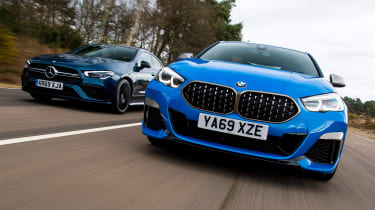
 New 2019 Mercedes-AMG CLA 45 S review
New 2019 Mercedes-AMG CLA 45 S review